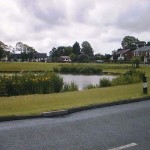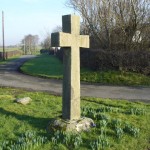Wrea Green was simply known as “Wray” up until the late nineteenth century. The village became known as “Wrea Green” to avoid confusion with the village of Wray, near Hornby. Indeed, the change of name was pressed for, by the incumbent vicar of the day – the long serving Rev. RS Stoney whose mail was arriving frequently in the wrong town.

The parish of Ribby-with-Wrea consisted of Ribby (The agricultural area) and Wray (The village). Both names are of Norse origin, Ribby (Rigbi) meaning “Ridge Settlement” and Wray (Vrai) meaning “Corner Nook”.
The local duck pond is known as “The Dub”, a term which probably derives from the word daub. Cottagers dug for daub and later clay to make their houses.
Ribby (Rigbi) was mentioned as far back as the Domesday Book, and was entered as comprising six caracutes. Roger de Poictou, a prominent resident provided the tithes of colts, calves, lambs, goats, pigs, wheat and cheese to the Priory of Lancaster to serve as food for all the monks. In 1201, the brothers, Adam and Gerrard de Wra paid two marks to King John, in order to gain protection from the local sherrif, who it seems was in the habit of molesting them in their tenements. The manors of Preston, Singleton and Ribby (Rigbi) were presented by Henry III to Edmond, Earl of Lancaster in 1286. In 1297, the year’s rents from Ribby-with-Wrea amounted to 19 shillings per annum
In 1683, James Thistleton, a local worker earning 4d a day died, leaving the substantial sum of £180 to build a new school for Wrea Green. This amount was quite astonishing considering Thistleton’s daily wage.

A second school and chapel was built in 1721 largely due to the trustees of the Nicholas Sharples charity, who purchased a piece of ground in Wrea Green in 1721 and erected a small chapel. Nicholas Sharples was a London Innkeeper who had spent much of his boyhood in Wray and upon hearing of James Thistleton’s genorosity, bequeathed £850 upon his death to the village towards maintaining a school.
The chapel was consecrated in 1755 by the Bishop of Chester.
The current church “St Nicholas” in the centre of the village was built 1848-49 and consecrated in 1855. The church and school are both Church of England as a request for methodism in 1887 was considered by the Rev. Stoneycroft as “hardly desirable”.
The village green is the largest in Lancashire and upto the middle of the twentieth century, it was not uncommon for cattle and horses to graze on the green. There were at least three ponds on the green, although two were filled in and levelled at the bequest of the cricket team, for a level cricket pitch.
There are still some bylaws concerning the Green that make interesting reading:
1. No person shall drive or wheel any cart, truck or other vehicle onto the village Green.
2. No person shall beat or shake carpets or rugs.
3. No person shall dig, cut or remove any sods.
4. No person shall light a fire.
5. No person shall hold a public meeting, religous, political or otherwise on the green.
Additional interesting notes from old minute books include facts such as:
In 1897, Wrea Green suffered a plague of sparrows. 1/2d was paid per sparrows egg, sparrow or rat’s tail.
In 1898, it was decreed that any traveller placing a horse on the green shaould pay sixpence a day.
In 1905, Wrea Green Cricket Club asked permission to level and lay out a portion of the green as a cricket pitch. In 1916, John Marquis of the Grapes Hotel was sent a letter asking him to take steps to prevent his pigs from damaging and disturbing the soil and surface of the village Green.
Wrea Green remained a quiet rural village, with agriculture as the main source of employment, until after the second world war. In 1891 the population was 401; in 1951 it was 697 and in 1981 it was 1464. Now only a small proportion of the village population depend on agriculture for their livelihood and people work in the surrounding towns, mainly in manufacturing and service industries.
Wrea Green is still a charming village and has won the Lancashire ‘Best Kept Village’ award on several occasions. The Church and its grounds are very well maintained and regularly win the award for the ‘Best Kept Churchyard’.
Books
Further information can be obtained from the following books:
“History of Wrea Green – including the School” by Anne Berry, available from the School Secretary, price £2.50.
“History of Wrea Green Church” by Anne Berry, available from the Verger.
“The History of Wrea Green” by Martin Ramsbottom, available from the Post Office, price £l.95